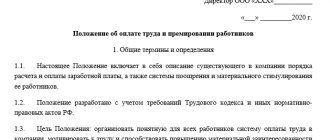An order approving the wage regulations is a document, after signing which this regulation begins to officially come into effect. We'll tell you how to draw it up and approve it.
In accordance with Article 12 of the Labor Code, any intra-company regulatory act comes into force from the date of its adoption by the employer. Acceptance must be documented. For these purposes, the order approving the regulations on remuneration in the new edition serves. In this article we will tell you how to correctly draw up this order. After all, only a properly executed document has full legal force and does not raise doubts or complaints from supervisory and regulatory government agencies.
Regulations on remuneration as a local normative act
The regulation is a set of rules according to which remuneration for labor is carried out to employees of a particular company. That is, this normative legal act resolves the following issues:
- payroll rules;
- advance amount;
- terms of issuance, transfer of advance payment and main payment;
- place of implementation, issuance of wages;
- the employer's liability for delays and non-payment, that is, for failure to fulfill obligations for timely payment of labor.
The Labor Code of the Russian Federation states that for his work a citizen must receive a set salary at least twice a month. Specific dates are established by the internal documents of the organization, as specified in the Labor Code of the Russian Federation. In accordance with Art. 142 of the Labor Code of the Russian Federation, in the event of a delay in payment for more than 15 days, the employee has the right to independently, at his own decision, suspend work until the employer fulfills financial obligations (prior written notification is required). Although the right to suspend activities is used extremely rarely by employees, this decision can create big problems for the employer. Practice shows that citizens more often use pickets and rallies to protect their rights, rather than the methods established by law. For example, in 2020, miners from Gukovo, after declaring a hunger strike, decided to stage a march on Moscow, but this did not lead to the satisfaction of their demands, but only aroused the interest of law enforcement agencies. Citizens often block federal highways in order to draw attention to their problems.
Thus, the Regulation on Remuneration is a fundamental internal regulatory act, although it is not included in the list of mandatory ones by the legislator.
Sample notice of changes in wages
External and internal economic factors may become prerequisites for the revision and change of wages at the enterprise. This measure is unpleasant and undesirable for both employees and management, but it is inevitable.
Stabilization of financial problems and reduction of losses in economic activity is often regulated by underestimating costs, and the first of them is wages .
The need to compile
The decision to reduce wages is made by the founders or the management staff in agreement with them. Personnel are notified by written notification of changes in wages . According to the legislation of the Russian Federation, this procedure is mandatory.
The notification form does not have any specialized form or established template, but must contain detailed information about :
- the reasons that led to these improvements or deteriorations;
- the employee’s ability to agree or refuse the proposed conditions;
- other earning options and relevant vacancies if the employee does not agree with the innovations.
Also, without fail, the form must indicate :
- name of the enterprise, its details, as well as employee data;
- number;
- main terms offered;
- signatures.
The signatures of both parties indicate that the employee was notified. If you disagree with the changes or choose another option from those proposed, the employee gives a counter-answer in writing .
All amendments, after agreement by the parties, are included in the employment agreement.
Normative base
The legal relationship between the employee and management regarding all working relationships, including remuneration and changes to it, is regulated by the Labor Code of the Russian Federation .
When signing an employment contract, the salary itself appears to be one of its fundamental conditions . Thus, introducing changes to the tariff rate specified in the contract is possible only with consensus between the two parties.
Therefore, the management staff of the organization does not have the authority to raise or reduce wages individually.
Management is obliged to notify employees of upcoming changes in wage conditions (this may concern not only the size, but also the period between accruals, new pricing methods, etc.).
If all points are agreed upon and a positive response from the employee, an auxiliary agreement , which is an integral part of the employment contract, i.e. application to it.
Form, order, design
As was already indicated earlier, a change in operating criteria does not happen based solely on the wishes of management. This will require compelling reasons and valid prerequisites , for example:
- reorganization in special technologies of the production process;
- global organizational events;
- general decline in the production process as a whole;
- suspensions in the operation of the enterprise due to lack of demand, etc.
Consequently, if an organization begins to experience financial problems, then its management may reduce losses by reducing the salaries of employees with consignment of their early notification - this technique is absolutely legitimate .
However, it is impossible to exclude cases when employers, due to such legislative permission, will illegally increase income by charging smaller amounts to their own employees.
The law provides for mandatory paper execution of a decision to reduce an employee’s salary with a clear description of the grounds for such a conclusion and its necessity in the current circumstances.
Moreover, such a decision made by the management staff must be confirmed by relevant documents :
- Accounting and tax documents , which confirm the actual results of the organization’s functional activities (balance sheet, audit report, etc.).
- Internal (letter, note on the state of the company’s financial affairs, orders on organizational events, changes in production process technology, etc.).
Requirements for filling
Legislative standards of the Russian Federation do not provide employers with a clear, standardized template for notification of changes in wage conditions. But, despite this, a notification drawn up at random must include a number of essential points , with explanations in detailed form:
- Prerequisites for planned changes in the regime, forms and amount of salary payments.
- Legal provisions for employees, with the ability to accept proposed amendments to the employment contract or to abstain from them and leave the company.
- A list of available jobs in this organization that you can choose if you disagree with changes in the conditions of remuneration at your current place.
Thus, according to the norms of the Labor Code of the Russian Federation, there must be an official form indicating the location and name of the organization.
It was mentioned earlier that the main aspect of the message is the reason for change . Within the framework of legal relations between employers and workers, the latter have the right to find out the details of all criteria for cooperation, including the prerequisites for changing the conditions of new payments (Article 21 of the Labor Code of the Russian Federation).
Since the salary of any employee is the result of his consensus with the employer, which is reflected in the employment contract, any notice is considered individual, that is, it is generated separately for each employee personally and includes information about innovations, introduction dates, categories of employees who will be affected by them.
Often, the personnel department of an enterprise has its own form for notification of changes in payment terms. This is convenient because each specific institution uses unique forms of accrual and payment of wages.
Notice deadlines
Important points that you should pay attention to when compiling are the timing and procedure for notifying working personnel:
- The message is submitted no later than 60 days before predictable changes (Article 74 of the Labor Code of the Russian Federation).
- During the entire next period and by the date specified in the document, management does not have the right to change the terms of payment of wages, remove the worker from performing his functions, reassign him to another position, etc.
- Together with the message, the employer is obliged to provide a list of available jobs that he can choose if he disagrees with the innovations.
An employee has the legal right not to accept new conditions and not to agree with the vacant jobs presented (Article 74 of the Labor Code of the Russian Federation). What happens in this case?
An employee's dismissal from his position can actually be made in accordance with a disagreement with the changed work criteria and directly from the date of their entry into force. The employer is obliged to pay the person being dismissed a remuneration in the amount of the average monthly salary.
Conclusion
Drawing up a notice and providing it to the employee is mandatory . Anyone, even a novice HR officer, can issue a message about changes in wage conditions.
The document is created in a free-form, indicating certain important aspects. Failure to provide a notice with two signatures may result in an audit and sanctions from municipal regulatory authorities, including the Federal Service for Labor and Employment.
If the employer does not inform its employees about changes in the rules for calculating and paying salaries in advance, this can become a serious reason for a long legal battle.
Is the employer obligated to notify the employee about changes in wages? The answer to the question is in this blog.
https://youtu.be/ZgQ0G9D5KJg
How to approve a salary clause
As already mentioned, this normative act is not mandatory. But it is worth adopting to clarify the wage system and prevent conflicts on this basis. For the document to take effect, you need to:
- familiarize employees with its contents;
- obtain signatures from them;
- issue an order to introduce wage regulations;
- sign such an order.
It is the date of the order that is considered the day the order comes into force. It itself may date to a different date - and that’s okay. After all, the likelihood that all employees will read the text and sign in a few hours is extremely low, especially for large enterprises.
If it is necessary to postpone entry into force, such a clause can be reflected in the text of the order.
Example of an order
There are no strict requirements for the content of the order. You can issue it either on letterhead or on a regular sheet of paper. The document consists of the following components:
- Order cap. Here you need to indicate the full name of the organization.
- Title. Consists of the title of the document, its serial number, as well as the number and date of the provision that is being approved.
- City (left) and date (right).
- Main text. You can start by justifying the need to introduce such a regulatory act.
- The need to familiarize the state with the contents of the local act on wage rules.
- Responsible person. FULL NAME. and the position of the employee to whom the manager entrusts the authority to control the execution of the order.
- Signatures. Two people sign the order on the wage regulations - the manager who issued it, and the person in charge.
Sample order for approval of wage regulations
There is no need to put the organization’s seal on the order, since the paper will not leave the company.
The wage order must be registered in the internal documentation journal and stored for the duration of its validity. After this, you can archive it. The order to put the payment provision into effect (as well as the main document) is kept in the archives for 75 years. Orders to amend local regulations are kept for the same amount of time.
Additional agreement to the employment contract on salary changes for 2020
Business entities involve employees in their business activities by concluding employment agreements with them.
These contracts reflect in detail the basic working conditions of hired persons, including what remuneration they are entitled to for performing labor functions.
If there is a salary increase, the law requires that an additional agreement be drawn up to the employment contract regarding the salary change.
In what cases is a salary change made?
The basis for paying wages to a person working at an enterprise is the employment contract concluded with him, and the management order issued on its basis.
If an employee works the required period of time per month or produces a specified amount of product, then he is entitled to the amount minus mandatory withholdings (personal income tax).
As a rule, if an employee has a set salary, then it will be constant from month to month, provided that the working person carried out his work all the time.
The company's management has the right to periodically revise the staffing table in the direction of increasing salaries. It can do this both voluntarily and in accordance with the law.
The rules of law establish that the salary at the enterprise for employees with normal working hours per month should not be less than the minimum wage established in the region and in the country. Therefore, when government agencies increase it, the company also needs to implement a corresponding increase.
Attention! From 2020, all business entities that employ hired personnel under labor contracts must index wages once a year. It involves an increase in the current salary by an indexation coefficient determined by internal regulations when prices for consumer goods and services rise.
In addition, companies and entrepreneurs can independently decide to increase salaries if they have the financial capabilities and in order to increase the interest of employees in working for the enterprise.
Is it necessary to draw up an additional agreement and why?
Information on the amount of remuneration in an employment contract is one of the most important terms of the agreement, without which the contract may be considered inappropriately executed.
Important! Simply issuing an order to change employee benefits in a company is not enough. First, you need to reflect changes to the employment contract regarding salary changes in an additional agreement or draw up a new contract with the employee.
What exactly needs to be done is decided by the company administration in consultation with the employee. If you only need to change the salary, and all other conditions remain the same, it is recommended to draw up an additional agreement to the contract previously concluded with the employee.
When changes involve making significant adjustments to the old contract, it would be best to renew the new employment contract.
Only after this can management issue an order to increase wages, and the accountant will be able to accrue remuneration based on the new wages for employees.
What to consider when changing your salary
Parties to labor relations must remember that changes in the amount of remuneration can only be formalized in writing. At the same time, both the company management and the employee himself must sign either an additional agreement or a new employment contract.
In some cases, a change in salary may be accompanied by a decrease in salary. Cases when this can be done are strictly listed in the Labor Code of the Russian Federation, for example, changing the organizational structure. In this case, the company administration is obliged to warn the employee about this event at least two months in advance.
https://youtu.be/P8H1dt7-us8
For individual entrepreneurs, this period is reduced to two weeks. In this case, the employer must offer vacant positions to employees whose salary is expected to be reduced if there are vacancies.
Attention! Any official can initiate a salary change by submitting a report addressed to management. After signing the additional agreement and issuing the order, appropriate changes must be made to the company’s staffing table.
The procedure for changing salaries in 2020
The procedure for increasing salaries may be caused by annual indexation, or the manager may decide to reward an employee. This can be documented as follows:
Step 1. Drawing up a memo
An employee’s immediate supervisor can send a note to the company’s management with a request to increase the salary of a subordinate for success at work.
In the case of annual indexation, the responsible employee (usually the chief accountant) draws up a memo informing management about the need to comply with the requirements of the law. The director reviews the document and, based on it, gives orders to prepare the necessary forms.
Step 2. Determining the new salary amount
If annual indexation of wages is carried out, then it is necessary to recalculate the accruals by the established coefficient in order to determine new earnings.
Step 3. Registration of the staffing table
It is necessary to reflect future salary changes in the document. Depending on the scope of the corrections, you can formalize changes to the current form (if the salary changes for only a few employees), or develop a new staffing table.
Step 4. Issuing an order to increase wages
It is necessary to issue an order to increase the salary. This must be done both for a single change and for indexing. This order can also approve a new staffing table, or change the existing one, give instructions for drawing up additional agreements, etc.
salary change order
Step 5. Drawing up an additional agreement
Each employee affected by the promotion must enter into an additional agreement to their employment contract. This document will fix the new salary amount and determine from what date it will be effective.
How to draw up an additional agreement to an employment contract on salary changes
When drawing up an additional agreement, three parts are conventionally distinguished: introduction, text part and conclusion.
In this case, the text part can include not only information that the employee’s salary will change from a certain date, but also any other information necessary for the change.
This will make it possible not to draw up several additional agreements for the same employment contract with different changes.
The introductory part briefly, but at the same time succinctly, sets out all the necessary conditions under which the additional agreement is signed. In particular, it is in this part of the document that it is necessary to indicate the legal grounds upon which the contract is changed.
Mandatory for use in the introductory part are:
- Place and date of execution of the agreement;
- Full details of the parties - full name. employee and manager, or entrepreneur;
- Their exact positions.
The additional agreement always indicates exactly the same number of parties as there are in the main agreement. If the quantity differs, then the additional agreement can be declared invalid and the changes made to it illegal.
Also in this section it is necessary to indicate the date from which the additional agreement comes into force. When the salary changes, it can be either the 1st day of the current month or the next. This item actually determines from what month the employee will actually have a new salary.
At the end of the introductory part, you also need to indicate information about the order or other document that serves as the basis for the changes, as well as information on the concluded employment agreement.
The next part is the main text of the agreement. The conditions that need to be changed, supplemented or deleted are indicated here. When describing the conditions, it is necessary to describe in as much detail as possible where the data to be replaced is located, and what exactly it needs to be replaced with.
In particular, reference must be made to the number of the item in which the information being replaced is located. When specifying numerical expressions, only Arabic characters must be used.
If the salary is changed, it is necessary to indicate the number of the item being changed, as well as its new content.
The final part contains the details of each party to the agreement:
- For an organization, its name, TIN, KPP, OGRN codes, and location address are indicated;
- For the employee, his full name, information about the identity document, and address of residence are entered.
Attention! In addition to the required signatures, a seal is placed on the agreement if it is used by the organization. Also on the form there should be a reference to the fact that there is a second copy of the document, and that the employee received it in person.
Source: https://buhproffi.ru/dokumenty/dopolnitelnoe-soglashenie-k-trudovomu-dogovoru-ob-izmenenii-oklada.html
How is employee orientation carried out?
This usually happens before the conclusion of an employment contract. If the regulation is adopted for the first time, when the activity has already been carried out and the staff has been formed, it is necessary to familiarize existing employees with it.
For reporting purposes, a familiarization sheet is prepared. The legislation does not provide for a strict form. It usually exists in tabular form and includes the following information:
- serial number;
- FULL NAME. employee;
- his position;
- structural unit or department;
- signature stating that you have read the regulations;
- date of.
The form looks something like this:
| No. | FULL NAME. employee | Job title | Structural subdivision | Acquaintance mark | |
| Signature | date | ||||
| 1 | 2 | 3 | 4 | 5 | 6 |
| 1 | Petrov Vladimir Stepanovich | Engineer | Workshop No. 1 | Petrov | 07.09.2019 |
| 2 | Grigoriev Ivan Vasilievich | Mechanic | Workshop No. 4 | Grigoriev | 07.09.2019 |
| 3 | Prokhorova Maria Ivanovna | Accountant | Department of Economics and Statistics | Prokhorova | 07.09.2019 |





